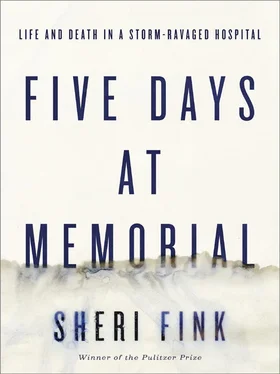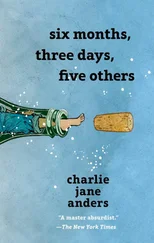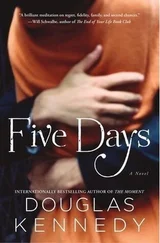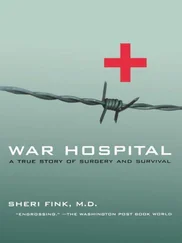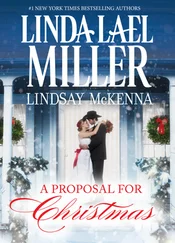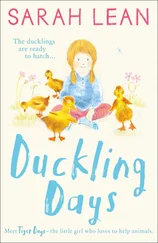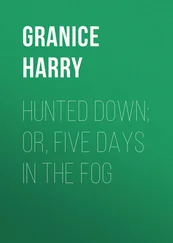He also wondered about the remaining pets, which he’d heard would be released from their kennels to fend for themselves. They were hungry. And Thiele was sure that another kind of “animal” was poised to rampage through the hospital looking for drugs. He later recalled wondering at the time: “What would they do, these crazy black people who think they’ve been oppressed for all these years by white people… God knows what these crazy people outside are going to do to these poor patients who are dying. They can dismember them, they can rape them, they can torture them.”
What would a family member of a patient want Thiele to do? There was no one left to ask; they had all been made to leave, told their loved ones were on their way to rescue.
The first thing, he thought, was the Golden Rule, do unto others as you would have them do unto to you. Thiele was Catholic and had been influenced by a Jesuit priest, Father Harry Tompson, a mentor who had taught him how to live and treat people. Thiele had also adopted a motto he had learned in medical school: “Heal Frequently, Cure Sometimes, Comfort Always.” It seemed obvious what he had to do, robbed of almost any control of the situation except the ability to offer comfort.
This would be no ordinary comfort, not the palliative care he had learned about in a week-long course that certified him to teach the practice of relieving symptoms in patients who had decided to prioritize this goal of treatment above all others.
There were syringes and morphine and nurses in this makeshift unit on the second-floor lobby. An intensive care nurse he had known for years, Cheri Landry, the “Queen of the Night Shift”—a short, broad-faced woman of Cajun extraction who had been born at the hospital—had, he believed, brought medications down from the ICU. Thiele knew why these medications were here. He agreed with what was happening. Others didn’t. The young internist who had helped him euthanize the cat refused to take part. He told her not to worry. He and others would take care of it.
In the days since the storm, New Orleans had become an irrational and uncivil environment. It seemed to Thiele the laws of man and the normal standards of medicine no longer applied. He had no time to provide what he considered appropriate end-of-life care. He accepted the premise that the patients could not be moved and the staff had to go. He could not justify hanging a morphine drip and praying it didn’t run out after everyone left and before the patient died, following an interval of acute suffering. He could rationalize what he was about to do as merely abbreviating a normal process of comfort care—cutting corners—but he knew that it was technically a crime. It didn’t occur to him then to stay with the patients until they died naturally. That would have meant, he later said he believed, risking his life.
He offered his assistance to Dr. Pou, but at first she refused him. She tried repeatedly to convince him to leave the area. “I want to be here,” he insisted, and stayed.
With some of the doctors and nurses who remained, Thiele discussed what the doses should be. To his mind, they needed to inject enough medicine to ensure the patients died before everyone else left the hospital. He would push 10 mg of morphine and 5 mg of the fast-acting sedative drug Versed and go up from there as needed. Versed carried a “black box” warning from the FDA, the most serious type, stating that the drug could cause breathing to cease and should only be given in settings where patients were monitored and their doctors were prepared to resuscitate them. That was not the case here. Most of these patients had Do Not Resuscitate orders.
It took time to mix the drugs, start IVs, and prepare the syringes. He looked at the patients. They seemed lifeless apart from their breathing—some hyperventilating, some gasping irregularly. Not one spoke. One was moaning, delirious, but when someone asked what was wrong, she was unable to respond.
He took charge of four patients lined up on the side of the lobby closest to the windows: three elderly white women and a heavyset African American man.
It had come to this. Dr. T’s mind began to form a question, perhaps in the faint awareness that there might be alternatives they had not considered when they set this course. Perhaps he realized at the moment of action that what seemed right didn’t feel quite right; that a gulf existed between ending a life in theory and in practice.
He turned to the person beside him, the nurse manager of the ICUs who also served as the head of the hospital’s bioethics committee. Karen Wynn was versed in adjudicating the most difficult questions of treatment at the end of life. She, too, had worked at the hospital for decades. There was no better human being than Karen. At this most desperate moment, he trusted her with his question.
“Can we do this?” he would later remember asking her. “Do we really have to do this?”

CHAPTER 1
FOR CERTAIN NEW ORLEANIANS, Memorial Medical Center was the place you went to ride out each hurricane that the loop current of the Gulf of Mexico launched like a pinball at the city. But chances are you wouldn’t call it Memorial Medical Center. You’d call it “Baptist,” its nickname since it had existed as Southern Baptist Hospital. Working a hurricane at 317-bed Baptist meant bringing along kids, parents and grandparents, dogs, cats and rabbits, and coolers and grocery bags packed with party chips, cheese dip, and muffulettas. You’d probably show up even if you weren’t on duty. If you were a doctor and had outpatients who were unwell, you might check them in too, believing Baptist a safer refuge than their homes. Then you’d settle down on a cot or an air mattress, and the hurricane, which always seemed to hit at night, would rage against the hospital and leave. The next day, the sun would rise and you would help clean up the debris and go home.
For nearly eighty years the steel and concrete hospital, armored in reddish-brown tapestry brick blazoned with gray stone and towering over the neighborhood near Claiborne and Napoleon Avenues, had defended those inside it against every capricious punch the Gulf’s weather systems had thrown. In 1965, it “took the century’s worst storm in stride,” weathering Hurricane Betsy “like a sturdy ship” and protecting more than one thousand people who sheltered inside, its administrator bragged in the hospital newsletter. A year before Katrina, when “[Hurricane] Ivan knocked, Memorial stood ready.” As Cathy Green, a nurse in the surgical intensive care unit, told her worried adult daughter when Katrina threatened: “If I’m in trouble at Baptist Hospital, if Baptist Hospital fails, it means the entire city would be destroyed.”
Utter faith in the hospital traced back to its founding: “I have an optimism that is almost explosive,” the president of the Southern Baptist Hospital Commission board of directors wrote in a letter to the hospital’s superintendent in February 1926, less than a month before a simple luncheon in the basement cafeteria and a dedication in the chapel marked the hospital’s opening. “In my humble opinion we have begun at New Orleans what is destined to be the greatest hospital in all the Southland.”
The property of the $2 million hospital stretched for two city blocks. Breathless news of its opening, with accompanying ads, occupied nearly three full pages of the Sunday, March 14, 1926, New Orleans Item-Tribune . The newspaper profiled the superintendent of the “magnificent” hospital, fifty-year-old Dr. Louis J. Bristow, and filled several column inches with a list of more than fifty of the items Bristow had carefully selected for it, from electrocardiographs to potato peelers. The hospital, its potential patrons learned, had the appearance of a modern hotel or private home, providing a “general atmosphere of cheerfulness” found wanting in New Orleans’s older hospitals. Nearly an entire page was given over to a tour that described such minute details as the lighting system that produced “ample illumination without glare,” the steam-heated blanket warmers on each floor, and the “dainty electric reading lamp” perched on each bedside table gracing the hospital’s private bedrooms. “Ice is frozen in cubes on each floor in sufficient quantities to supply all patients,” one article trilled. The stories, which read more like press releases or ad copy than news, may well have been penned by superintendent Bristow himself, or perhaps his daughter, Gwen, a writer. “The new institution stands unsurpassed among the hospitals of the south in point of modern conveniences.”
Читать дальше
